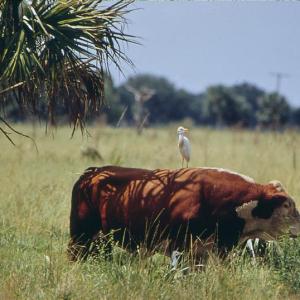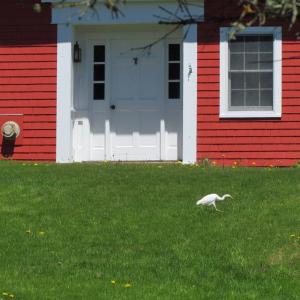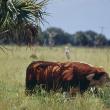A White Bird Among Cows
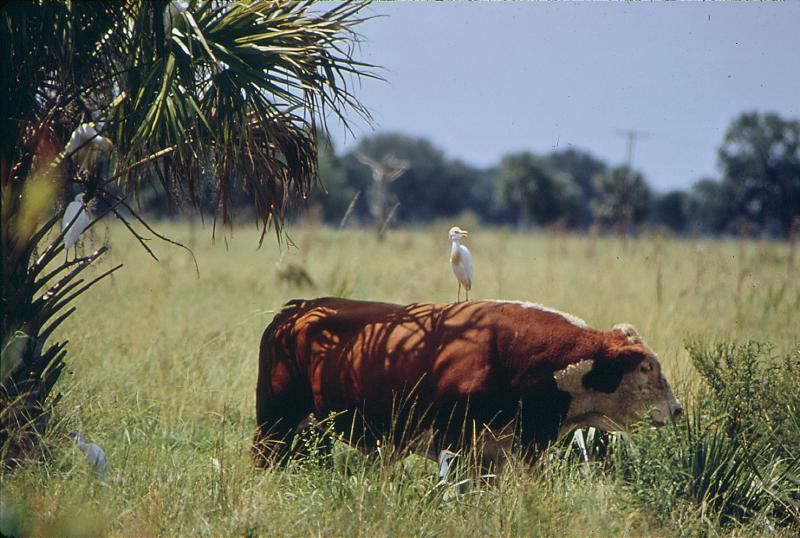 Cattle egrets are often found with large mammals, especially cows, as shown in this photo from Florida where cattle egrets are well-established permanent residents. Photo by Fred Ward, courtesy Wikimedia Commons.
Cattle egrets are often found with large mammals, especially cows, as shown in this photo from Florida where cattle egrets are well-established permanent residents. Photo by Fred Ward, courtesy Wikimedia Commons.
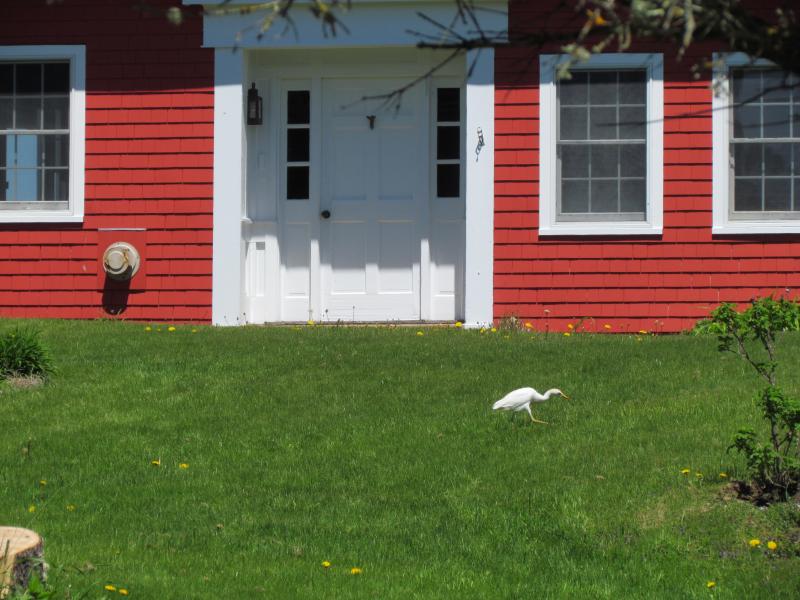 Cattle egrets often show up in Maine in the fall—but not always. The bird shown here was one of three that appeared on Monhegan Island in May of 2017. Courtesy of Jeff Wells.
Cattle egrets often show up in Maine in the fall—but not always. The bird shown here was one of three that appeared on Monhegan Island in May of 2017. Courtesy of Jeff Wells.
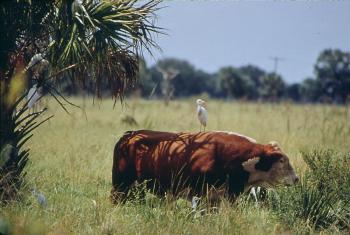 Cattle egrets are often found with large mammals, especially cows, as shown in this photo from Florida where cattle egrets are well-established permanent residents. Photo by Fred Ward, courtesy Wikimedia Commons.
Cattle egrets are often found with large mammals, especially cows, as shown in this photo from Florida where cattle egrets are well-established permanent residents. Photo by Fred Ward, courtesy Wikimedia Commons.
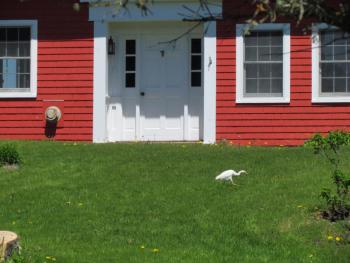 Cattle egrets often show up in Maine in the fall—but not always. The bird shown here was one of three that appeared on Monhegan Island in May of 2017. Courtesy of Jeff Wells.
Cattle egrets often show up in Maine in the fall—but not always. The bird shown here was one of three that appeared on Monhegan Island in May of 2017. Courtesy of Jeff Wells.
A pure white bird stalking around an open field among brown cows is pretty noticeable. Here in Maine, it’s also surprising—especially in late November.
No wonder that when that when the owners of a farm in Leeds, Maine, saw such a sight on November 28, they took photos and video, posted it on Facebook, and asked if anyone knew what the heck it was.
A friend shared it with us to see if we could help figure out the mystery. And we did.
The bird was a cattle egret.
Cattle egrets are very interesting birds in all sorts of ways. They are in the heron and egret family, but many herons and egrets are largely confined to wetlands. Cattle egrets, on the other hand, are commonly seen in open pastures, fields, and on lawns that may or may not have wetlands within them. Cattle egrets are great at capturing insects disturbed by cattle, horses, or other large grassland mammals, a behavior for which they have been known since centuries ago—thus the name “cattle egret.”
But what has set them apart from other herons and egrets is their history of an explosive range expansion from their original African and Asian range. Beginning in the late 1800s, cattle egrets began a steady march across much of the world. They first showed up in northeastern South America, apparently flying across from Africa on the prevailing easterly winds, in the late 1800 and early 1900s. Cattle egrets were first seen across various islands of the Caribbean beginning in the 1930s and 1940s. Within 30 years they had been documented on more than 30 islands of the region.
The first known cattle egret in North America was sighted in Florida in 1941. By 1953, they had already begun nesting there! Perhaps even more amazing is that the first one for the State of Maine was also in 1953—an individual that was shot in early December by a farmer in Brownfield.
In the years since then, cattle egrets have spread across most of the U.S. Here in Maine, some began nesting on Stratton Island off Scarborough around 1977; the colony reached a peak of 50 pairs in 1984. Numbers declined after that to just a few pairs each year. The reasons why they declined are not well understood, but the last known breeding pair of cattle egrets in Maine occurred there in 1995.
Cattle egrets still are seen annually in Maine, often (but not always) in the fall. For most herons and egrets, immature birds are well-known for making very long-distance movements after the breeding season, sometimes far north of their breeding range. Presumably, it is precisely this behavior that opened the door for the rapid expansion of cattle egrets across so much of the world over the last 150 years.
Many other herons and egrets, though, also show this same large-scale movement behavior but didn’t show explosive range growth as did cattle egrets. However, other herons don’t show the same preference for foraging in open, often wetland-less lands. Cattle egrets may have expanded their range in Africa and Asia because of conversion of forested landscapes to agricultural lands. That expansion in numbers probably then allowed more cattle egrets to disperse to places like South America where forest clearing for agriculture also provided lots of the habitat they preferred. From there, individuals that dispersed kept finding more and more of that agricultural habitat as they moved north into the U.S. Even here in Maine, the breeding birds on Stratton Island used to fly about eight miles inland to a farm in Saco to forage in a cow pasture. We well remember watching them there from the side of the road on a number of occasions.
A cattle egret in Maine in late November on a farm, foraging among a herd of cows, is pretty special and unusual. But not unprecedented, and certainly not out of character for this fascinating bird.
Jeffrey V. Wells, Ph.D., is a Fellow of the Cornell Lab of Ornithology and Vice President of Boreal Conservation for National Audubon. Dr. Wells is one of the nation's leading bird experts and conservation biologists and author of the “Birder’s Conservation Handbook.” His grandfather, the late John Chase, was a columnist for the Boothbay Register for many years. Allison Childs Wells, formerly of the Cornell Lab of Ornithology, is a senior director at the Natural Resources Council of Maine, a nonprofit membership organization working statewide to protect the nature of Maine. Both are widely published natural history writers and are the authors of the popular books, “Maine’s Favorite Birds” (Tilbury House) and “Birds of Aruba, Bonaire, and Curaçao: A Site and Field Guide,” (Cornell University Press).

